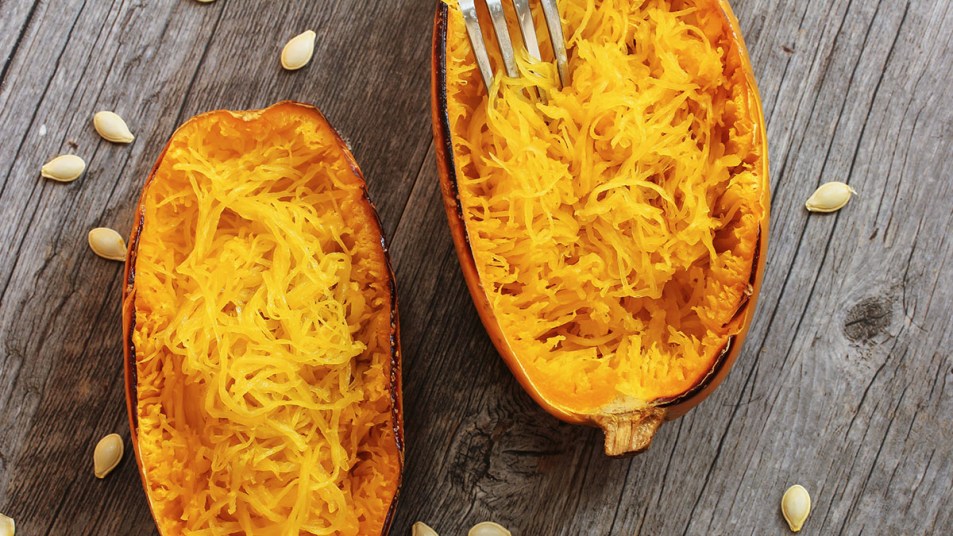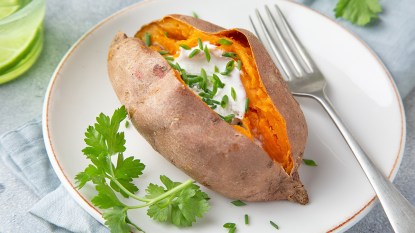The Tasty Fall Veggie Can Help You Lose Weight, Lower Blood Pressure, and Boost Bone Health

Spaghetti squash is impossible to miss whenever we’re browsing the produce section at the grocery store. The big, bright yellow squash always stands out, but it can seem daunting to grab. Now that it’s fall, though, it’s the perfect time to bite the bullet and put one in your cart. Not only is it super tasty, it’s packed with a plethora of health benefits.
Spaghetti squash gets its name from the pasta-like fibers inside that can be a great low-calorie substitute at any meal. It works as a replacement for pasta, with the filling serving as the base of any meal you can think dish. From a bolognese to a chicken Alfredo, spaghetti squash passes every taste test.
The veggie is in season in fall in winter, and Dr. Tara Weir says that’s exactly when we should think about trying it.
“Food that is grown locally and eaten in season often tastes better and provides more health benefits compared to food that is imported,” Dr. Weir says. “Fruits and vegetables lose nutritional value during storage and transportation. This means that produce that is allowed to ripen naturally and eaten fresh (or frozen when fresh) tends to be more nutrient-dense.”
What does it taste like?
Spaghetti squash is the perfect way to indulge in a winter vegetable thanks to its versatility. It can stand in for pasta, be thrown in a soup, or used as it’s own bowl thanks to its sturdy shell. Most recipes feature the unique step of putting the mixed filling right back in to the shell when serving, giving it a fun look.
The squash itself has a mild, neutral taste that isn’t overwhelming and is less strong than most other squashes. It can also be faintly sweet, depending on the seasoning. What sets it apart is it’s texture. The strands are a bit crunchier than a regular pasta dish and pair nicely with lots of different toppings. The noodle-like filling can also be slightly watery, depending on how it’s cooked.
There are two main ways to cook the squash. You can cut it, either lengthwise or cross wise, and then bake cut-side down in the oven with a little oil drizzled on the inside. Or, if you find the cutting a bit hard due to its exterior shell, you can bake the squash whole. This step would just take a bit longer.
After it’s cooked, simply run a fork through the inside to turn it into noodles!
What are the health benefits of spaghetti squash?
The two main benefits of spaghetti squash is that it’s low in calories and rich in micronutrients like vitamins, minerals, and antioxidants, Weir says. It’s especially a good source of manganese, vitamins C and B6, and beta carotene.
Manganese is a trace mineral found in our bones, making this squash great for those looking for a boost in bone health. The vitamins C and B6 help make your immune system stronger, while the beta carotene gets converted into vitamin A after we digest it. This vitamin is vital for vision health and also helps support our hearts lungs and kidneys.
That’s still not all spaghetti squash is good for! Weir says the “high-fiber, nutrient-dense” squash may have benefits for digestion and healthy weight control. It also may help to reduce the risk of diabetes and blood cholesterol.
Spaghetti squash is great for well-rounded weight loss diets due to its fiber content, which can help empty your stomach. Fiber also regulates blood sugar levels. Since spaghetti squash is rich in antioxidants, which aid in preventing diabetes, the tasty vegetables is great with people struggling with their blood sugar spikes.
It can also aid in regulating your blood pressure thanks to the potassium. People with high blood pressure are often advised to up their potassium intake since it lessens the effects of sodium.
That’s quite the number of benefits! Next time you’re at the store, pick up a spaghetti squash to boost your health with little work.













